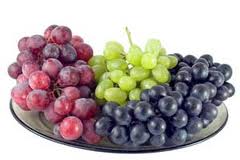 Each time we offer Holy Communion at our church, a third element joins the Bread and Cup at our Table: a plate of grapes. When a child comes forward who is not yet ready to receive the Bread and the Cup, the pastor offers a grape, as a reminder of the seed of faith that is growing in that child.
Each time we offer Holy Communion at our church, a third element joins the Bread and Cup at our Table: a plate of grapes. When a child comes forward who is not yet ready to receive the Bread and the Cup, the pastor offers a grape, as a reminder of the seed of faith that is growing in that child.
How is your seed of faith doing these days?
Is it growing in you?
Growth brings with it a lot of discomfort. Remember what it was like as a child to get ready for school each August? Remember how your shoes felt when you tried them on after a summer of running around barefoot? Tight, right? Kind of like new wine in old wineskins – ready to burst at the seams. Growing does that to you. It makes the old comfortable ways seem suddenly uncomfortable.
How is your growing faith making your life uncomfortable right now? And if you aren’t feeling some discomfort, how do you know you are growing?
This week, my husband marks a major milestone birthday. Next week, my son graduates from college. The week after that, I receive my Master of Divinity degree. Within a couple of weeks, three members of my family will have looked in the mirror and wondered, “How have I grown?” And immediately after that question comes an even bigger one: “What now?”
Growing into Christ-likeness is not easy. Growing as part of the Body of Christ can be downright uncomfortable. A friend of mine keeps a sign above her desk that reads, “Change is inevitable. Growth is optional.” When we opt for growth, we embrace the discomfort of moving into new territory. The question, “What now?” brings joyful anticipation instead of fear, for we know that the One who loved us enough to die for us is with us. Our growing faith is evidence of the Kingdom of God here and now, bringing us closer to the Kingdom of God that will be.
How’s your seed of faith doing these days? Is it growing in you? Can you embrace the discomfort that comes with growth? What do you see as evidence that God’s Kingdom is working in you and in your church right now?
Here, have a grape.


I have used grapes as part of a Maundy Thursday communion service in exactly the way Jo Anne describes above. Parents and children appreciate having a developing/anticipating place at the table. These families have requested, over the years, that this become a permanent part of communion. So I raised this option to John Weborg maybe 15 years ago. And in John’s unique way, he squinted at me and asked if I had the authority to add another element to communion? While he did not say it was inappropriate, he did make me pause. Clearly a new dimension in communion is the optional gluten-free bread for those with allergies. So, for now, I’m keeping the grapes as an occasional use until I can get John’s squint out of my mind.
Report This Comment
05.18.12 at 12:08 pm
I too am hesitant to add a “new element” to the table, but when it is clearly communicated that this is not a sacrament but a tactile way to look forward to the sacrament, I think its okay.
In the eastern Orthodox church, the non-Orthodox are forbidden from taking communion but one can approach the priest and receive “blessed bread”. They have a pretty high view of the sacraments, but it doesn’t seem to bother them to add an element that allows more people to come close to the table.
Report This Comment
05.18.12 at 3:44 pm
I appreciate John Weborg’s question – it’s a right one to ask. I also raise the point that the Lord’s Supper comes from a larger “Love Feast” and “Passover Seder” meal, from which the elements of bread (unleavened) and wine (the 3rd cup of redemption) arise as our Holy Communion. In the Seder context, everyone in the family participates in the event, and the meal includes other foods that are shared. How might this speak to the question of imaginative involvement in the narrative of the meal and inclusion of children and guests/strangers at the Table?
Report This Comment
06.02.12 at 8:25 am